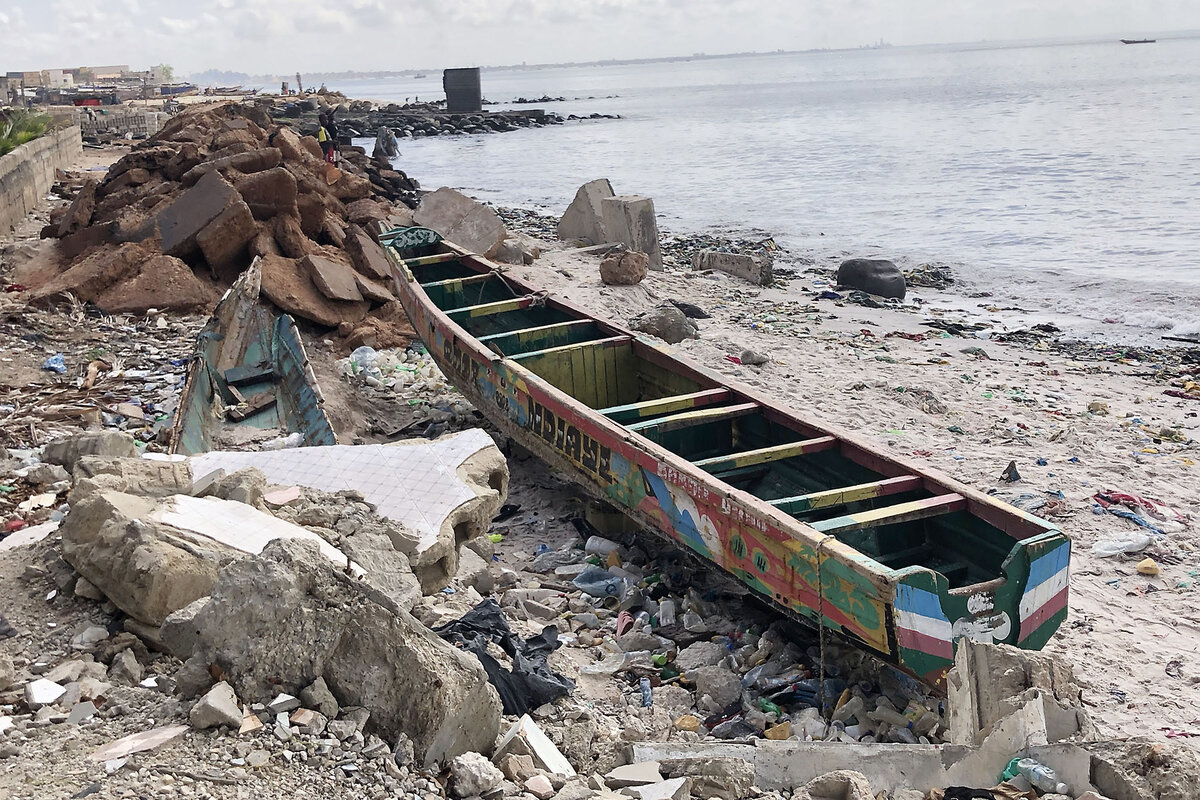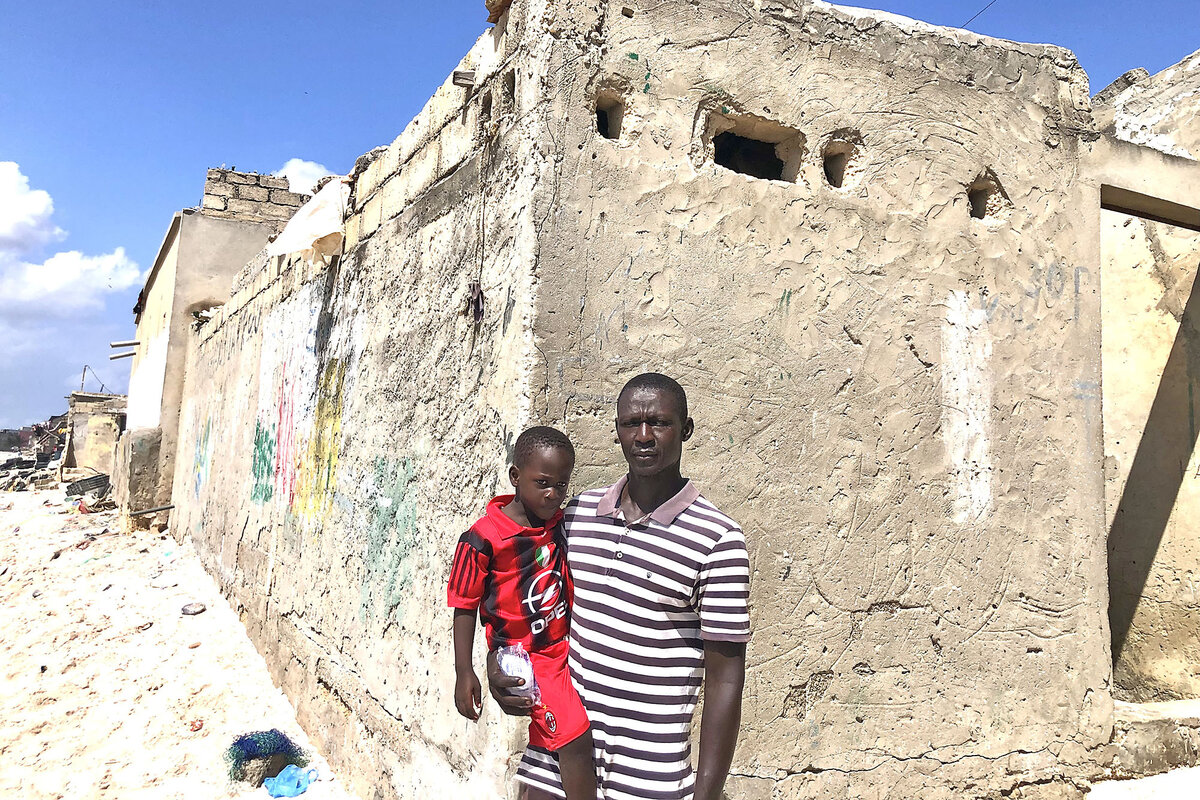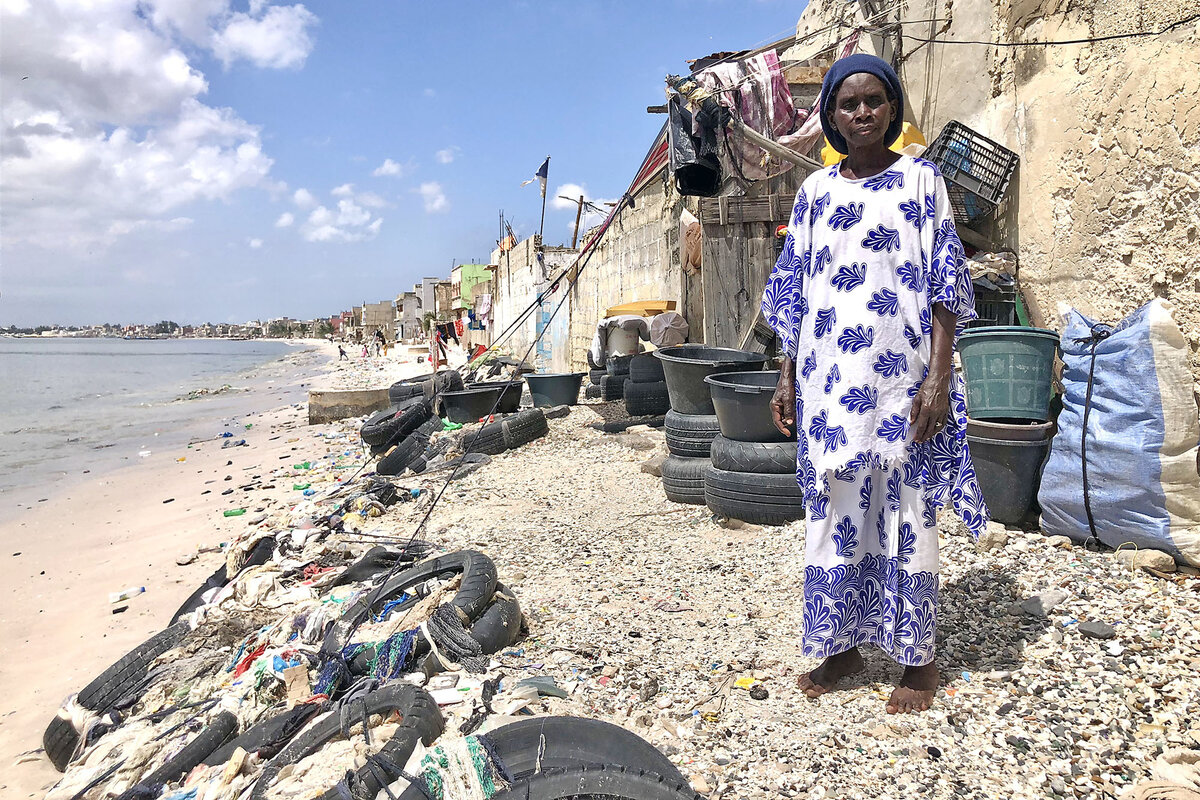Their houses are being swept into the sea. Why many Senegalese won’t leave.
Loading...
| Hann Bay, Senegal
Every time there’s a storm surge, a little bit more of Lambane Faye’s house breaks off into the ocean. Sometimes it’s a chunk of brick and other times, layers of paint. In August, 2-meter-high waves (over 6½ feet) crashed into his two-room house in this coastal suburb of Dakar, tearing a jagged, horizontal line through the foundation.
The damage led Mr. Faye to a logical conclusion. “Maybe it’s time to move,” he says.
But that is easier said than done. Mr. Faye, a car mechanic with a large family, doesn’t have the money to move homes. Promised government assistance has not materialized. And even if it were possible to leave, “where do you go?” he wonders.
Why We Wrote This
As sea levels rise, coastal communities around the world face an existential choice: stay and fight, or retreat to safer ground? In Senegal, that’s still an open question.
Senegal’s 466-mile coastline is the lifeblood of its economy – generating millions of jobs in fisheries, tourism, and horticulture – and providing homes to over 50% of the country’s population. But now, rising sea levels and coastal erosion are eating the land away.
“These extreme phenomena are damaging homes and livelihoods,” says Tidiane Diedhiou, a meteorologist at ANACIM, Senegal’s civil aviation and meteorological agency. “Coastal populations need to take precautions to make themselves less vulnerable.”
That leaves Senegal’s government and coastal residents like Mr. Faye facing an existential question: stay and fight, or retreat to safer ground?
A disappearing coastline
It is an urgent question. Sea levels off Senegal’s coast are rising by each year. The coast is receding by a rate between 0.5 and 1 meter annually, according to a government study – and scientists say more generally is highly vulnerable to erosion. In Senegal, the World Bank estimates that three-quarters of the coastline will be affected by erosion in the next half-century.
In towns like Hann Bay, some houses have been ripped away by the ocean; entire walls and rooftops are missing. Experts largely blame climate change for the rising sea levels here. But human activity on the coast undoubtedly makes erosion worse.
Although taking sand from the beach has been illegal in Senegal since 2009, people in places like Hann Bay continue to steal it – ironically to fortify their homes against the encroaching water. Residents and hotels regularly flout the rules, building within the legal (nearly 330 feet) from the shore.
“We can’t put a police officer behind every person,” says Mame Faty Niang, head of the coastal management division of Senegal’s environment directorate.
Stay or go?
For many residents of coastal Senegalese towns, life away from the ocean is simply unimaginable.
The August storm that tore a hole in Mr. Faye’s home damaged 174 houses in the nearby Dakar suburb of Thiaroye-sur-Mer.
The state provided financial assistance to their owners, but local authorities say long-term solutions are necessary – including simply removing people from vulnerable areas. One urban restructuring plan is already underway to rehouse 511 families farther inland.
But Me El Mamadou Ndiaye, the mayor of Thiaroye-sur-Mer, says that relocations should not be the norm.
“The local population is very connected to their land, which is why we need to focus on preserving it, not displacing everyone,” he says.
He suggests investing in more seawalls and protective barriers, a vision shared by Senegal’s government. It is currently working alongside nine other countries in West Africa on a large-scale coastal improvement project, with funding from the World Bank. The project will focus on cleaning up beaches, developing antiflood measures, and building protective barriers in key towns on Senegal’s coast.
A new way of thinking
But many here say that physical barriers can only do so much. People’s way of thinking also needs to change.
“People are attached to the sea, but sometimes we need to protect them from themselves,” says Mbacké Seck, an ecologist who runs the Hann Baykeeper initiative, which teaches residents here about curbing pollution and protecting the sea.
Over the last 20 years, Mr. Seck says, he has watched his hometown, like many others on Senegal’s coast, overtaken by what he calls “anarchic urban sprawl.” Even though laws forbid construction near the shore, big cities like Dakar are pinched for space, forcing people to build ever closer to the water’s edge.
“Building this close to the beach is no longer a viable option,” he says.
Population pressure has also transformed Hann Bay from a pristine, turquoise waterway to a place where children can no longer swim at the beach. Plastic bottles, shards of glass, and used rags litter the sand. Wooden fishing boats, painted in vibrant blues and greens, sit idle on the beach.
Some residents have put this garbage to good use. Hann Bay resident Yaye Coumba Ngom has kept her compact four-bedroom house standing for decades, even as her neighbors’ homes have been damaged or swept into the ocean. The secret, she says, is to create a wall around the house out of old tires stuffed with rags and shells. They absorb the water each time the ocean swells, and “we’ve managed to resist,” she says.
Meanwhile, Mr. Faye, whose house is slowly being nibbled away by the ocean, says he hopes to one day move inland, joining a brother who has already left town. But until then, when the next storm starts rolling in, he’ll do what he always does. With the help of friends, he will build a makeshift barrier around his house using bags of sand.
Then he’ll pack a few suitcases and go stay with a neighbor who lives farther from the water’s edge. And hope, each time, that his home will still be there when he returns.







